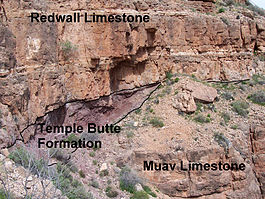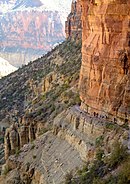| Muav Limestone | |
|---|---|
|
Stratigraphic range: Middle Cambrian [1] | |
 representative sequence of Redwall Limestone, Temple Butte Formation, and Muav Limestone, in Grand Canyon | |
| Type | Geological formation |
| Unit of | Tonto Group [2] |
| Underlies | either the Frenchman Mountain Dolostone ( Cambrian) or Redwall Limestone ( Mississippian). Locally underlies Temple Butte Formation ( Devonian) that fills narrow paleovalleys cut into the Muav Limestone. |
| Overlies | Bright Angel Shale |
| Thickness | 830 feet (250 m), at maximum |
| Lithology | |
| Primary | limestone and dolomite |
| Other | shale and intraformational conglomerate. |
| Location | |
| Region | Northern Arizona (Grand Canyon), central Arizona, southeast California, southern Nevada, and southeast Utah |
| Country | United States of America |
| Type section | |
| Named for | Muav Canyon, north side of Colorado River [3] |
| Named by | Noble (1914) [3] |
The Muav Limestone is a Cambrian geologic formation within the 5-member Tonto Group. It is a thin-bedded, gray, medium to fine-grained, mottled dolomite; coarse- to medium-grained, grayish-white, sandy dolomite and grayish-white, mottled, fine-grained limestone. It also contains beds of shale and intraformational conglomerate. The beds of the Muav Limestone are either structureless or exhibit horizontally laminations and cross-stratification. The Muav Limestone forms cliffs or small ledges that weather a dark gray or rusty-orange color. These cliffs or small ledges directly overlie the sloping surfaces of the Bright Angel Shale. The thickness of this formation decreases eastward from 250 feet (76 m) in the western Grand Canyon to 45 feet (14 m) in the eastern Grand Canyon. To the west in southern Nevada, its thickness increases to 830 feet (250 m) in the Frenchman Mountain region. [2] [4]
Beyond the Grand Canyon area, the Muav Limestone is recognized in southern Utah, southern Nevada and southern California. [5] In parts of California, it is known and mapped as the Muav Marble. [6]
Nomenclature
In 1875, G. K. Gilbert [7] mapped the Tonto Group within the lower part of the Grand Canyon. At that time, Gilbert subdivided it, from oldest to youngest, into the Tonto Group into the Tonto sandstone, Tonto sandstone, and Marbled limestone.
In 1914, L F. Noble [3] renamed Gilbert's three subdivisions of the Tonto Group. Noble renamed Tonto sandstone as the Tapeats Sandstone; the Tonto shale as the Bright Angel Shale; and the Marbled limestone as the Muav Limestone. As defined by Noble in 1914, his Muav Limestone consisted of "...the predominantly calcareous part of the Tonto group. lying between the underlying Bright Angel Shale and either discontinuous lenses of overlying Devonian beds or base of the Redwall Limestone.
In 1922, L F. Noble [8] subdivided the Muav Limestone into four informal subdivisions. From top to bottom, his subdivisions are subdivision A, bluff massive dolomite; subdivision B, gray cross-bedded sandstone; subdivision C, thin-bedded mottled limestone; and subdivision D, basal thin-bedded mottle limestone.
Later in 1945, E. D. McKee and C. E. Resser [9] removed subdivision A of L F. Noble from both the Muav Limestone and the Tonto Group and assigned it to an informal geologic unit called the Cambrian undifferentiated dolomites. This created an informal geologic unit that is composed entirely of dolomite overlying the Muav Limestone that is composed largely of limestone. [9] Finally, S. M. Rowland and others [1] [10] formally named the Cambrian undifferentiated dolomites as the Frenchman Mountain Dolostone and restored it to the Tonto Group. [2]
Contacts
The Muav is in part younger than, and in-part grades into, the underlying Bright Angel Shale. To the west, the underlying Bright Angel Shale interfingers complexly with the overlying Muav Limestone. Its upper contact with the overlying Frenchman Mountain Dolostone is a well-defined disconformity. The Muav Limestone is overlain in the western Grand Canyon by the Cambrian Frenchman Mountain Dolostone. Eastward, the Frenchman Mountain Dolostone pinches out and the Mississippian Redwall Limestone, which forms prominent vertical cliffs, directly lies upon the Muav Limestone. Discontinuous lenses of Devonian Temple Butte Formation fill deep paleovalleys that have been cut into and occasionally through the Frenchman Mountain Dolostone and into the Muav Limestone. [2] [4]
Fossils
The body fossils of invertebrates found in the Muav Limestone are infrequent and often poorly preserved. They include sponges, brachiopods, hyoliths, helcionelloids, trilobites, eocrinoids, and enigmatic invertebrates. The types of body fossils reported from the Muav Limestone are not as diverse as those reported from the Bright Angel Shale. The invertebrate body fossils are dominated by ptychopariid and corynexochid trilobites. The Muav Limestone is likely not substantially younger than the Bright Angel Shale, as it contains trilobites of the same age as trilobites found in the Bright Angel Shale of eastern Grand Canyon region. In addition, to trilobites, the Muav Limestone contains enigmatic body fossils such as hyoliths; the single-shelled, mollusk Helcionella; Scenella hermitensis; and Chancelloria. [2] [11]
Although trace fossils are common in the Muav Limestone, they are less abundant than those found in the underlying Bright Angel Shale. They consist of invertebrate burrows and trails and Girvanella-like structures ( oncolites). [12] Pervasive bioturbation of the calcareous sediment is responsible for the mottled appearance of most of the Muav Limestone. [13]
Depositional Environment
It is currently accepted that that Muav Limestone accumulated in an offshore marine environment during a series of at least five transgressive and regressive events. These events are reflected the in five members into which the Muav Limestone has been subdivided and the step-like pattern in which the Muav Limestone interfingers with the underlying Bright Angel Shale and diagonally crosses time planes. Presumably, these transgressions are the result of rapid, periodic, rises in relative sea level, interrupted by at least four drops in relative sea level that caused regressions of lesser extent. The interfingering of shales and sandstones of the Bright Angel Shake into the limestones of the Muav Limestone are the result of such transgressive and regressive events. [9] [12]
Gallery – Muav Limestone
-
Muav Limestone cliff example, below Redwall Limestone cliff, on the North Kaibab Trail (closeup photos, often show purple erosion debris)(expandable photo)
-
(view due-north, northeast, from Bright Angel Trail, (South Rim section) – View of south-draining Bright Angel Canyon, containing in its lowest section with the Tapeats Sandstone, upon the Granite Gorge, the cliffs of gray-brown Muav Limestone (25% at base of Redwall Limestone), laid upon the slope-forming & greenish Bright Angel Shale. (The trail also descends/ascends through units on the South Rim, at near photo view.)
-
View to Sumner Butte, Redwall Limestone peak & vertical cliff, sitting on Muav Limestone
See also
References
- ^ a b Karlstrom, K.E., Mohr, M.T., Schmitz, M.D., Sundberg, F.A., Rowland, S.M., Blakey, R., Foster, J.R., Crossey, L.J., Dehler, C.M. and Hagadorn, J.W., 2020. Redefining the Tonto Group of Grand Canyon and recalibrating the Cambrian time scale. Geology, 48(5), pp. 425–430.
- ^ a b c d e Connors, T.B., Tweet, J.S., and Santucci, V.L., 2020. Stratigraphy of Grand Canyon National Park. In: Santucci, V.L., Tweet, J.S., ed., pp. 54–74, Grand Canyon National Park: Centennial Paleontological Resource Inventory (Non-sensitive Version). Natural Resource Report NPS/GRCA/NRR—2020/2103. National Park Service, Fort Collins, Colorado, 603 pp.
- ^ a b c Noble, L.F., 1914. The Shinumo quadrangle, Grand Canyon district, Arizona. U.S. Geological Survey Bulletin. 549. doi: 10.3133/B549. ISSN 0083-1093.
- ^ a b Middleton, L.T. and Elliott, D.K., 2003. Tonto Group, in Beus, S. S., and Morales, M., eds. Grand Canyon geology Museum of Northern Arizona Press, Flagstaff, Arizona. pp. 90–106.
- ^ Wood, W., 1966. Facies Changes in the Cambrian Muav Limestone, Arizona. Geological Society of America Bulletin, 77(11), pp.1235-1246.
- ^ Hamilton, W.B., 1987. Mesozoic geology and tectonics of the Big Maria Mountains region, southeastern California. Arizona Geological Society Digest, v. 18, pp. 33-45.
- ^ Gilbert, G.K., 1875. Report upon the geology of portions of Nevada, Utah, California, and Arizona, Chapter 6. In Wheeler, G.M., ed., pp. 17–187, Report on the Geographical and Geological Explorations and Surveys West of the One Hundredth Meridian, vol. 3. U.S. Geological and Geographical Survey, Publication of the Wheeler Survey, Washington, D.C., 681 pp.
- ^ Noble, L.F., 1922. A section of the Paleozoic formations of the Grand Canyon at the Bass Trail. U.S. Geological Survey Bulletin. 131-B, pp. 23–73
- ^ a b c McKee, E.D., and Resser, C.E., 1945, Cambrian history of ;the Grand Canyon region. Carnegie Institution of Washington Publication 563, 168 pp.
- ^ Rowland, S.M., Korolev, S., Hagadorn, J.W. and Ghosh, K., 2023. Frenchman Mountain Dolostone: A new formation of the Cambrian Tonto Group, Grand Canyon and Basin and Range, USA. Geosphere, 19(3), pp.719-747.
- ^ Lassiter, S.L., Tweet, J.S., Sundberg, F.A., Foster, J.R., and Bergman, P.J., 2020. Chapter 5. Paleozoic Invertebrate Paleontology of Grand Canyon National Park. In: Santucci, V.L., Tweet, J.S., ed., pp. 109-236, Grand Canyon National Park: Centennial Paleontological Resource Inventory (Non-sensitive Version) . Natural Resource Report NPS/GRCA/NRR—2020/2103. National Park Service, Fort Collins, Colorado, 603
- ^ a b Miller, A.E., Marchetti, L., Francischini, H., Lucas, S.G., 2020. Paleozoic invertebrate ichnology of Grand Canyon national Park. In: Santucci, V.L., Tweet, J.S., ed., pp. 277–331, Grand Canyon National Park: Centennial Paleontological Resource Inventory (Non-sensitive Version). Natural Resource Report NPS/GRCA/NRR—2020/2103. National Park Service, Fort Collins, Colorado, 603 pp.
- ^ Schuchert, C. 1918. On the Carboniferous of the Grand Canyon of Arizona. American Journal of Science (4th series) 45(269), pp. 347 and 361.
Further reading
- Blakey, and Ranney, 2008. Ancient Landscapes of the Colorado Plateau, Ron Blakey, Wayne Ranney, c 2008, Grand Canyon Association (publisher), 176 pages, with Appendix, Glossary, Index. Contains approximately 75 shaded topographic maps, for geology, etc., with 54 (23 pairs, (46)) for Colorado Plateau specifically; others are global, or North American.
External links
- Abbot, W, (2001) Revisiting the Grand Canyon – Through the Eyes of Seismic Sequence Stratigraphy. Search and Discovery Article # 40018, America Association of Petroleum Geologists, Tulsa, Oklahoma.
- Anonymous (2006) Muav Limestone, Stratigraphy of the Parks of the Colorado Plateau. U.S. Geological Survey, Reston, Virginia.
- Hartman, J. H. (2001) Muav Limestone, Grand Canyon National Park, Coconino County, Arizona. GeoDIL, A Geoscience Digital Image Library, University of North Dakota, Grand Forks, North Dakota.
- Mathis, A., and C. Bowman (2007) The Grand Age of Rocks: The Numeric Ages for Rocks Exposed within Grand Canyon, Grand Canyon National Park, Arizona, National Park Service, Grand Canyon National Park, Arizona.
- Rowland, S. (nda) Frenchman Mountain and the Great Unconformity. Department of Geoscience, University of Nevada, Las Vegas, Nevada.
- Rowland, S. (ndb) Geologic Map of Frenchman Mountain. Department of Geoscience, University of Nevada, Las Vegas, Nevada.
- Stamm, N. (2013) Geologic Unit Muav (Limestone), National Geologic Database. U.S. Geological Survey, Reston, Virginia.


